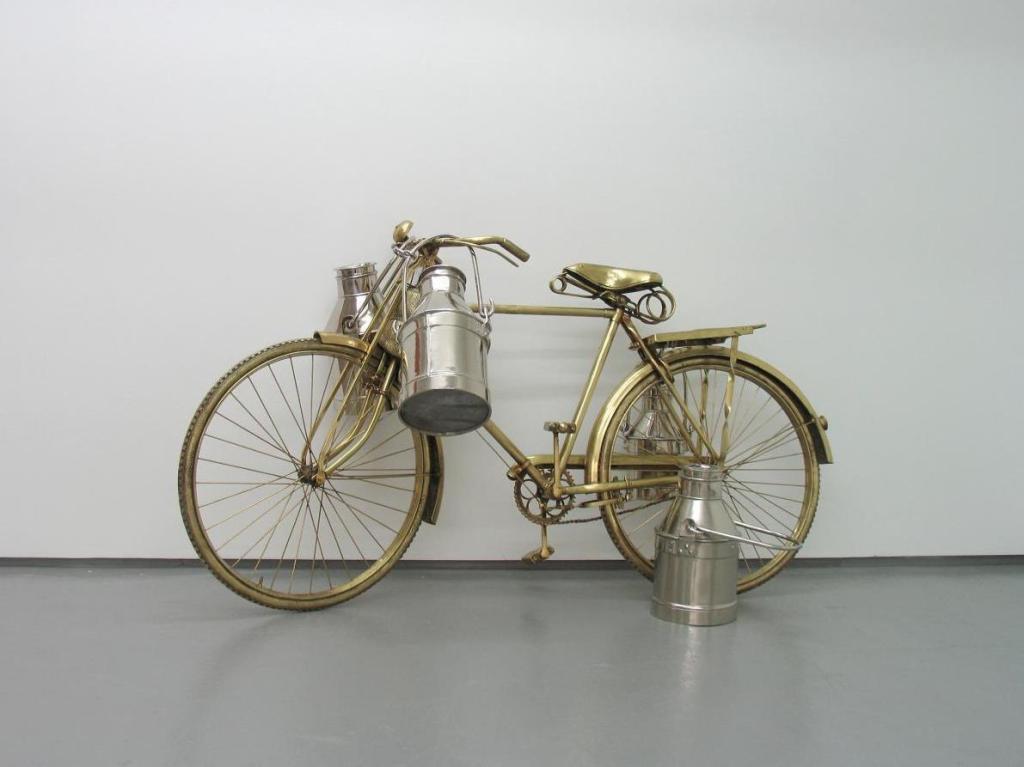Image: Cow 2003 bronze, aluminium; collection of Larry Walsh, New York.
Hidden in the middle of a labyrinth of corridors on the first floor of the NGV International is something akin to a Hindu shrine. But you won’t find images of Krishna, Vishnu or Shiva there. Presently showing in this small gallery space is the work of internationally acclaimed, contemporary Indian artist Subodh Gupta in the exhibition Everyday Divine. In collaboration with New York based art collector Larry Warsh, seven key works from Gupta’s oeuvre are on show, exploring the nature of the divine in the everyday. In the tradition of the early 20th century French artist Marcel Duchamp, Gupta’s ‘ready-mades’ or sculptures of domestic objects and street life are elevated to another level of understanding in the gallery context.
Growing up in Bihar province, one of India’s poorest and least developed regions, Gupta draws on these humble beginnings and his Hindu beliefs to explore, through gentle humour, Indian culture, religion and history. Trained as a painter, Gupta now works across media, exploring his ideas through sculpture, installation, paint, photography, video and performance; the ready made and installation however are the feature of this exhibition.
Entering the gallery space the visitor is overwhelmed by a great wave-like installation of stainless steal kitchen utensils; Hungry God, (2005-06) pays homage to the domestic realm in which Gupta likens the modern-day Indian kitchen to a secular temple. Cultural references abound in much of the artist’s work. For Gupta, stainless steal represents the transformation from old to new India under the economic plan of Prime Minister Nehru in the 1950s and 1960s. Gupta uses other metals such as bronze and aluminium to elevate the everyday objects to a shrine-like status.
Key works such as Cow, (2003) a life-size sculpture of a bicycle with milk pails and This side is the other side (2001), a motor scooter also with milk pails, both cast in bronze and aluminium, mirror each other from opposite sides of the room. Representing the old and new, the everyday and the divine, Gupta plays with the notion of the cow, a creature revered in Indian culture, in the mechanized form. ‘In the country if I wanted milk, I would go to the cows to get it; in the city it is delivered to you by bicycle,’ he says. The work Gober Ganesha (2004), also in bronze and aluminium, consists of a vessel containing bronze cow patties and makes reference to aspects of village life and livelihood while symbolizing an offering with religious connotation.
Although a small gallery space the combination of large and smaller works have been arranged in such a way as to allow each piece room to be transformed and become points of contemplation for the viewer, in the tradition of a shrine. Minimal labeling and information panels support the quietly austere environment although a multimedia screen on the outer wall of the gallery, introducing the artist to the visitor, would have been a valuable addition and provide further context and depth to the show. An interesting and thought provoking exhibition well worth a visit if you are in Melbourne but be prepared to give it the time and contemplation it deserves.
Rating: 3 stars out of 5
Subodh Gupta: Everyday Divine
NGV International Melbourne
Exhibition 13 May – 16 October 2016
Free admission





